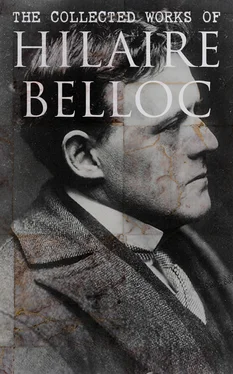Let us first appreciate exactly how matters looked to Souham when, on the 15th, the Thursday, the blow was about to fall upon him.
He had under his orders, with headquarters now at Courtrai, now at Menin (see sketch map on p. 58), rather less than 40,000. In that dash upon Courtrai a fortnight before, which had led to the dangerous establishment of so large an advanced body in front of the main French line, one main effect of that advance had been to push back, away to the left beyond the Lys, more than 16,000, but less than 20,000 men under the Austrian General, Clerfayt. With that army, Clerfayt’s body, Souham had remained continually in touch. Detachments of it were continually returning to the valley of the Lys to harass his posts, and, in a word, Clerfayt’s was the only force of the enemy which Souham thought he had need to bear in mind.
The bulk of the Austrian army he knew to be quite four days’ march away to the south, at first occupied in the siege of Landrecies, and later stationed in the vicinity of that fortress.
Of course, lying in his exposed position, Souham knew that a general attack upon him from the south was one of the possibilities of the situation, but it was not a thing which he thought could come unexpectedly: at any rate he thought himself prepared, by the use of his scouts and his spies, to hear of any such advance in ample time.
In case he should be attacked, the attack might take one of many forms. It might try to drive him over the Lys, where Clerfayt would be ready to meet him; or it might be a general attack upon Courtrai as a centre; or it might be (what had, as we have seen, been actually determined) an attempt to cut him and all his 40,000 off from the main French line.
This main French line ran through the town of Lille, and Lille not only had its garrison, but also at Sainghin, outside the fortifications to the south-east, a camp, under Bonnaud, of 20,000 men. If the attack from the south or from the north, or from both, managed to cut Souham off from Bonnaud’s camp, and from the garrison at Lille, he was ruined, and his 40,000 were lost; but he hoped to be kept sufficiently informed of the enemy’s movements to fall back in time, should such an attempt be made, and to provide for it by effecting a junction with Bonnaud before it was delivered.
Pichegru, the Commander of the whole French army of the north, who had ordered the advance on Courtrai, happened to be absent upon a visit to the posts away south upon the Sambre River. Souham was therefore temporarily in full command of all the troops which were to be concerned in the coming battle. But the position was only a temporary one, and that must account for the deference he paid to the advice of the four generals subordinate to him, and for the council which he called at Menin on the critical Saturday night which decided the issue. He himself quotes his commission in the following terms:—“Commander-in-Chief of all the troops from the camp at Sainghin to Courtrai inclusive.”
From the beginning of the week, when a detachment of his troops had but just recovered from a sharp action with the Duke of York’s men towards Tournai, Souham appreciated that the forces of the enemy were gradually increasing to the south of him, and that the posts upon the Scheldt were receiving additional enforcements of men. But neither his judgment nor the reports that came in to him led him to believe that the mass of the Austrian army was coming north to attack him. And in this he was right, for, as we have seen, the Emperor did not make up his mind until Wednesday the 14th, which was the day when orders were sent to the Arch-Duke Charles to march northward.
Souham’s attitude of mind up to, say, the Thursday may be fairly described in some such terms as follows:—
“I know that a concentration is going on in the valley of the Scheldt to the south and east of me; it is pretty big, but not yet exactly dangerous, though I shouldn’t wonder if I were attacked in a few days from that quarter. What I am much more certain of is that active and mobile force which I beat off the other day, but which is still intact under the best General opposed to me, Clerfayt. I hear that it is marching south again, and my best troops and my offensive must be directed against that. I am far superior in numbers to Clerfayt, and if I can bring him to an action and break him, I can then turn to the others at my leisure: for the moment I have only one front to think of—that on the north.”
But the negligence which he or his informants were guilty of—a negligence that was to prove so nearly fatal to all those 40,000 French troops—consisted in the failure to discover what was up upon Friday the 16th.
During those twenty-four hours the Arch-Duke Charles had brought up his column to St. Amand; the other four columns upon the Scheldt were concentrated, and upon the north of the Lys, Clerfayt had got orders to move upon Wervicq, and was, during the middle hours of Friday, actually upon the march. Yet, during all that day, Friday the 16th, Souham remained ignorant of the extremity of his peril.
The orders which he dictated upon the Friday night, and largely repeated upon the following morning of Saturday the 17th of May, show how little he expected the general action that was upon him. He arranged, indeed, for a cordon of troops to be watching, in insufficient numbers, the side towards the Scheldt, and he sent to Bonnaud and the camp at Sainghin, outside Lille, orders to keep more or less in touch with that cordon. The instructions to this cordon of troops along the eastern side of the French position is no more than one of general vigilance. It is still to Clerfayt and towards the north alone that he directs an offensive and vigorous movement.
In a word, he was a good twenty-four hours behind with his information. He was wasting troops north of the Lys in looking for Clerfayt at a time when that General was already on the march to Wervicq, and he was leaving a scattered line of insufficient bodies to meet what he did not in the least expect, the rapid advance of Bussche, Otto, and York during that Saturday upon Mouscron, Tourcoing, and Roubaix.
Therefore it was that although Bussche’s insufficient force was driven out of Mouscron at last by superior numbers, Otto and York succeeded in sweeping all the resistance before them, and, in the course of that Saturday, reached the first Tourcoing, the second Roubaix, and even Mouveaux.
The whole problem of warfare consists in a comparison between the information that each side has of the movements of the other. The whole art of success in war pivots upon the using of your enemy’s ignorance. Had the allies upon this occasion been more accurate in keeping to their time-table, and somewhat more rapid in their movements, they would have caught the French commander still under the illusion that there was no danger, save from the north, and would have succeeded in cutting off and destroying the main French force by getting in all together between Courtrai and Lille. For at that same moment, the early hours before daybreak of the 17th, the allies had begun their movement.
Table of Contents
The terrain over which the plan of the allies was to be tested must next be grasped if we are to understand the causes which led to its ultimate failure.
That terrain is most conveniently described as an oblong standing up lengthways north and south, and corresponding to the sketch map overleaf. That oblong has a base of twenty miles from east to west, a length from north to south of thirty-five.
These dimensions are sufficient to show upon what a scale the great plan of the allies for cutting off Souham at Courtrai was designed.
At its south-eastern corner the reader will perceive the town of St. Amand, the furthest point south from which the combined movements of the allies began; while somewhat to the left of its top or northern edge, at the point marked “A,” the northern-most body connected with that plan, the body commanded by Clerfayt, was posted at the origin of the movement.
Читать дальше












